WORLD CLASS COACHING
Spanish Style Possession Soccer Vol 1
By Philip Cauchi
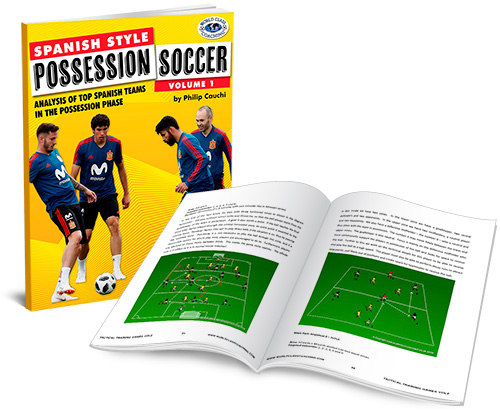
Table of Contents
PART THREE
Training Methodology
The Power of the Rondo
Training methodology
The modern game requires players who read and anticipate situations quickly. It is not about how the formation is set on the tactics board. Formations mean nothing as players continuously move according to the requirements of the game situations. It is therefore imperative that players are trained to read and interpret situations that are derived directly from the game itself.
Players should be able to identify the right moment when to move into space to receive the ball, how they can create space for their teammates while dribbling the ball, and how they help their teammates to double team their opponent during the non-possession phase of the game. Hundreds if not thousands of other situations exist in soccer. We should however keep in mind that no situation is the same as another. The game is unpredictable with the players having to continuously perceive stimuli and make the right decisions while under pressure from the opponents.
Not only must players learn to take ownership of the problems to make decisions, but they also need to be in line with the collective tactics of the team (Grima, 2016). This cannot be achieved if we train players to play without any opposition pressure. Although some technical work might be required, the component of decision-making should always be present in training. We want players who understand the game, can make decisions, and be pro-active rather than re-active.
Rather than drills or exercises, coaches should design and run training situations. These training situations have a better meaning and a better transfer of learning to the soccer field than drills. Let us consider the below training situation. This is a 4v2 rondo where the aim is for the goalkeeper, the central defenders and the defensive midfielder to develop their ability to retain possession of the ball under pressure. There is a consequence as there will be in a real match. If the ball is lost the chance of conceding a goal is high. However, through this exercise players will develop their positional awareness, communication and decision-making speed much better than through a technical drill performed without any opposition.
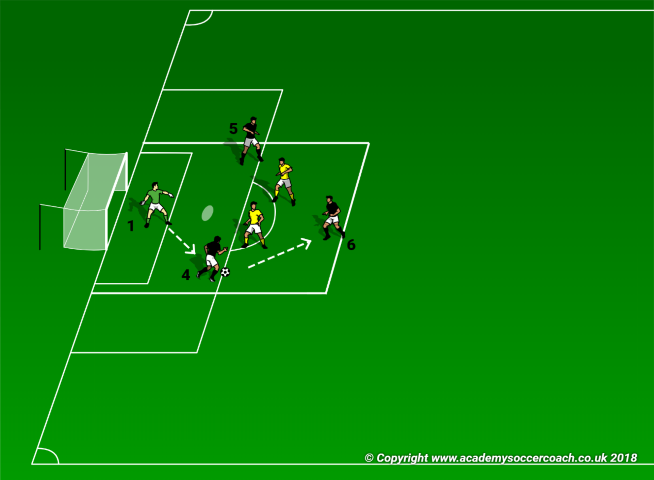
Touch restrictions in training such as playing one or two touch should be avoided in the global part of a training session (Grima, 2017). It is nonsense, for example, if a player has the opportunity to beat a defender to shoot at goal but cannot because there is a two touch restriction. It is just not realistic!
The power of the rondo
A powerful coaching tool which is typically used in Spain is the rondo. In a rondo the coach can create different scenarios, thus making the players think collectively on how they will solve a particular situation. There is everything in a rondo (except finishing) and the coach may choose if he wants to work on width or on achieving verticality (Bertolini, 2018).
A rondo is not simply keeping possession of the ball. Behind what we see as a group of players keeping possession there is a tactical aim. When presenting a rondo to the players, the coach should always explain the main aim and outcomes of how it will help the team increase their performance on match day. A rondo should be designed to develop the team’s principles of play (Fletcher, 2018).
Inter-sectoral communication can only be achieved if various lines from the team practice together (Bertolini, 2018). Moments of play such as keeping possession of the ball, transition and defending to win the ball back, all exist in a rondo (Fletcher, 2018). Players will thus develop the mentality of pressing immediately upon losing possession.
A rondo may be used at various levels. It is however important to keep in mind that when introducing a rondo to beginners or young players, we must start with a very easy and basic one. Perhaps we can start with a 4v1 in a relatively large area. The reason behind this is that these young players might not yet have the necessary first touch, passing technique and positional and spatial awareness required to keep the ball in tight areas. It would be futile getting angry with the players. We as coaches should be able to set the right height of the bar for our players and lead them towards further growth in the game by setting slightly more complex goals. Planning the way towards reaching these goals should be clear. The correct training situations should be planned, reviewed and adjusted accordingly. The work done with the players and tasks which have been accomplished should be recorded. This ensures that there is continuity in the work done throughout the years.
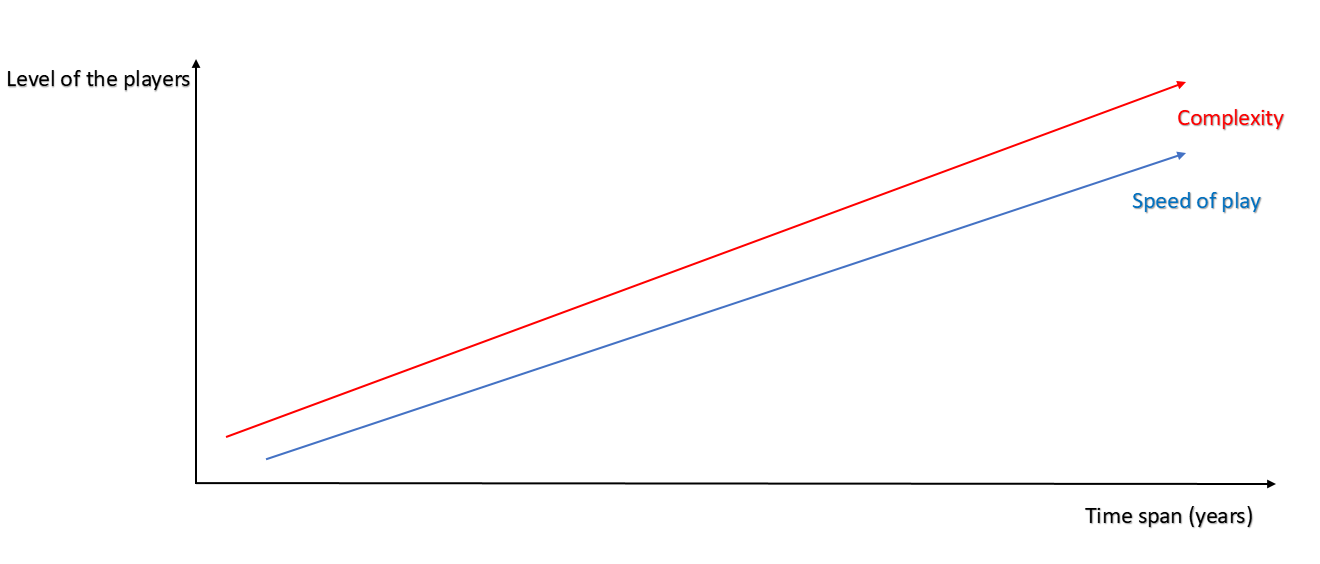
In a rondo, players should practice within their natural roles as this aids in the development of team collaboration. In the next diagram we see how a simple setup helps develop the collaboration and integrity of the team in central midfield while also involving a central defender and a striker.
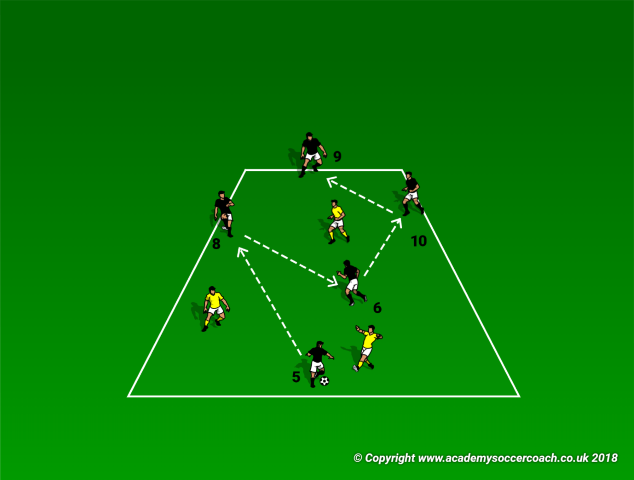
In a rondo the coach may choose to focus on a particular player or a sector and coach them through a real game scenario. In rondos one of the main principles is to form triangles. These triangles are necessary in order to create options and keep circulating the ball.
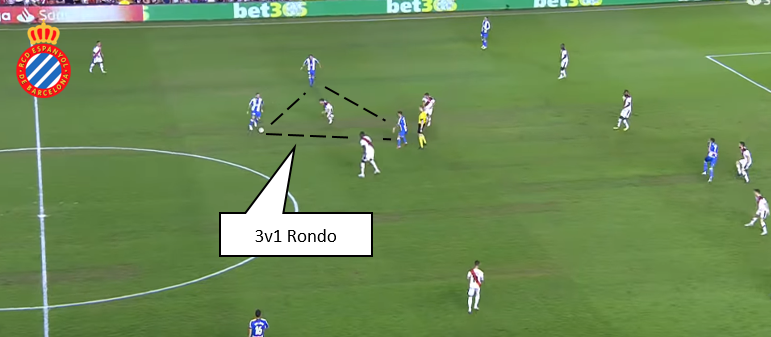
In the above diagram a clear 3v1 situation can be seen. If we analyse this further we find that another important element needed to secure the ball is the stance of the players. An open stance when in space enables players to play the ball at higher speeds. We can take the situation in the above image and replicate it in training. Now we can see the relevance of such a practice as midfielders are immersed in a similar situation which they will encounter during a match.
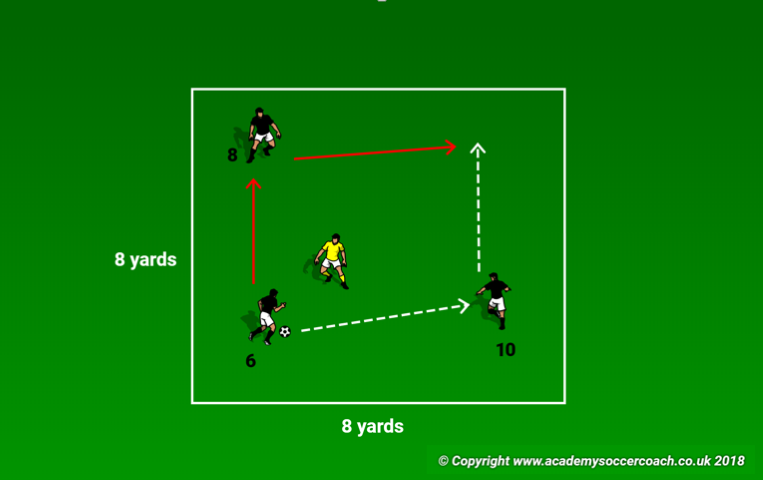
The purpose of every training session should be to improve the performance of the team. Therefore every minute the players spend at training should respect this. The cooperation and tactical understanding between the players of different sectors can be effectively developed and perfected using rondos.
The number of players participating in a rondo determine the major aim and outcomes of the practice. If we are practicing a 3v1 in a small area, the number of ball touches for each player is high. The decision-making process however is low as the only decisions the player on the ball can make is to either pass the ball (two passing options), or hold on to it. If we perform this practice in an analytical way and include a maximum of two touch restriction to play the ball, the technical execution speed will be even higher. Therefore, we can call this a technical rondo as it focuses more on developing the individual player’s technical ability rather than team tactics.
If we run a rondo with a higher number of players from different sectors of the team, the number of ball contacts for each player will be lower than in the 3v1. From a tactical perspective the players must be aware of their position, move at appropriate angles, rotate positions, provide support both near and further away from the ball, communicate both verbally and non-verbally with their teammates and read and anticipate situations. The latter type of rondo targets the development of game intelligence.
The creation of passing lanes are emphasized in rondos. Davies (2013) points out three passing lines which will help us understand how to conquer verticality either through a direct pass or by playing around the defenders.
The first line of pass is simply a pass played laterally or backwards and which does not bypass any of the defenders. Support from nearby teammates is necessary to perform this type of pass to secure possession of the ball.
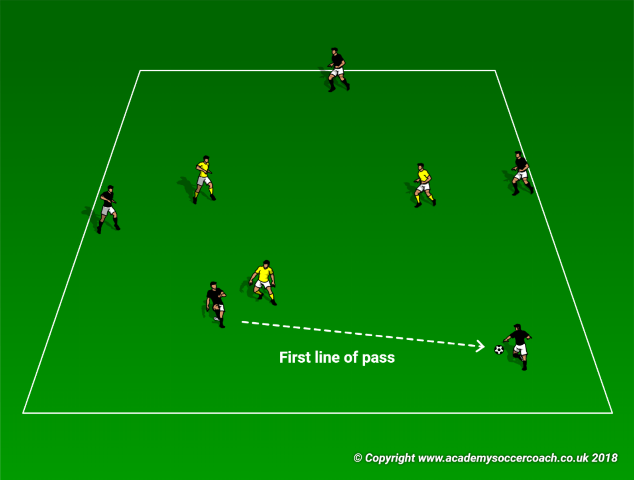
The second line of pass bypasses the defenders by playing around them. Again, support is needed to perform this action. As a performance outcome the receiving player should adapt the proper stance that will enable him to pass immediately to the third player.
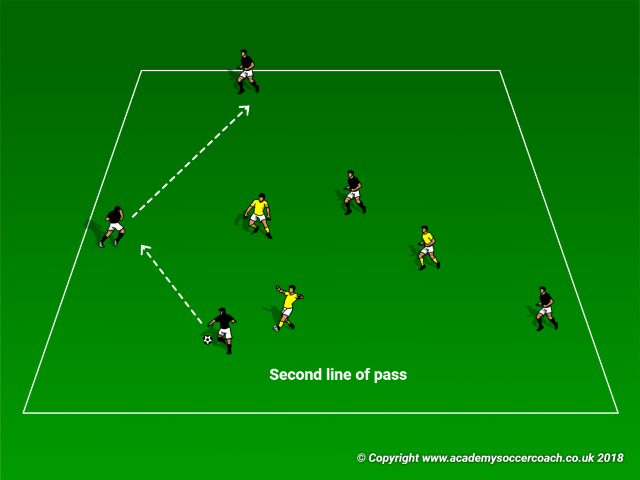
The third line of pass eliminates directly the defenders as it is played through them. Although they do not receive the ball, wide players are stretching the defenders, thus creating gaps to play through.
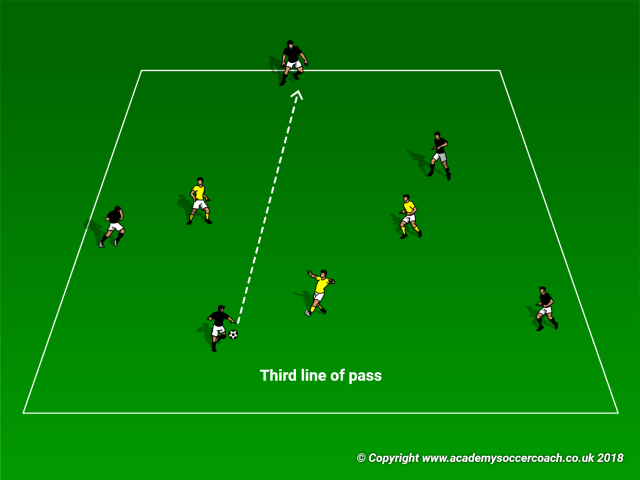
The same author also mentions the mig toc or the half a touch. This type of pass is just having the receiving player redirecting the ball to another player. Speed of play is thus increased and the ball becomes even harder for the defenders to intercept.
To create a rondo exercise we need to analyse what we want to develop in our team. We first need to identify what the problem is, the zone on the field of play and the affected players. We then need to create a situation in which players experience this problem on a regular occurrence. If we can take a video or a shot of the situation we want to work on, the players will better understand why this specific exercise can help them. The next image is an example taken from a match where the focus is on building up play from the back. Therefore we create the same situation where players are required to build-up play from one end to another. Once the aim of the exercise is known we need to target the outcomes required to achieve this aim. In this case we will work on having both length and depth, staggered angles, mobility (positional rotations), stance to receive and play the ball, direction oriented first touch and the quality of the pass.
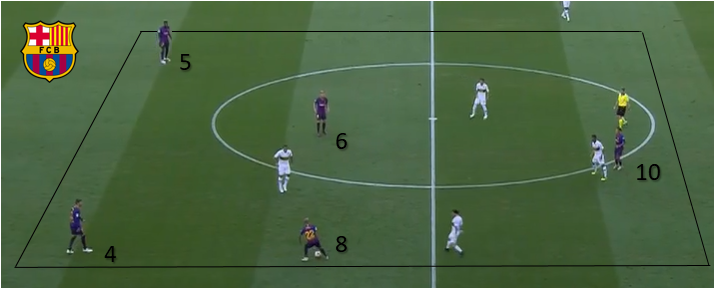
From the above game situation can emerge the exercise demonstrated in the below diagram. We have a situation of 6v4 in favour of the attackers (black team). To simplify the problem further we divided the area into a lower and an upper zone.
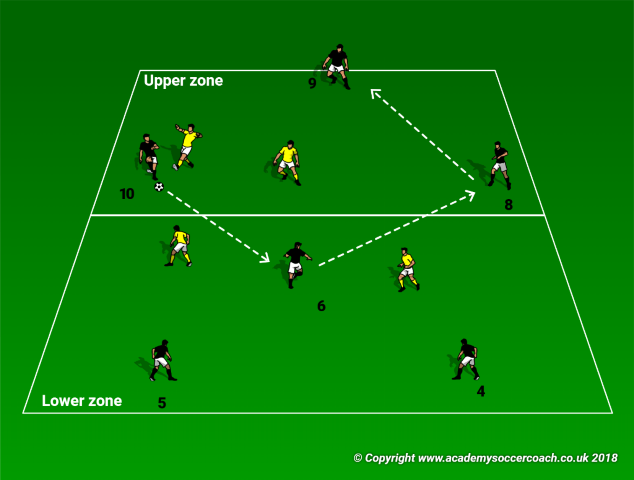
In each zone we have a 3v2 situation in favour of the attackers. The aim is to circulate and secure possession of the ball. At first players are restricted to remain inside their assigned zones. We progress this rondo by allowing rotations. If we take the situation in the above diagram it can be that player 8 drops into the lower zone while player 6 moves into the upper zone. As a final step we remove both zones and play in a single marked area. Players now do not have any markings aiding them to create depth and length and have various lines and angles of support.
The above exercise may be simplified for players of a lower technical ability. The below diagram demonstrates an easier variation of this exercise. Now we have a 6v3+1 situation where the neutral player (red) may freely move between zones thus always providing a 4v2 numerical advantage. The defending team may have two players in the zone of the ball. If the defenders win the ball, they aim to dribble it out of the area to score a point. The attackers inside the zone where the ball is lost must therefore immediately press to win it back.
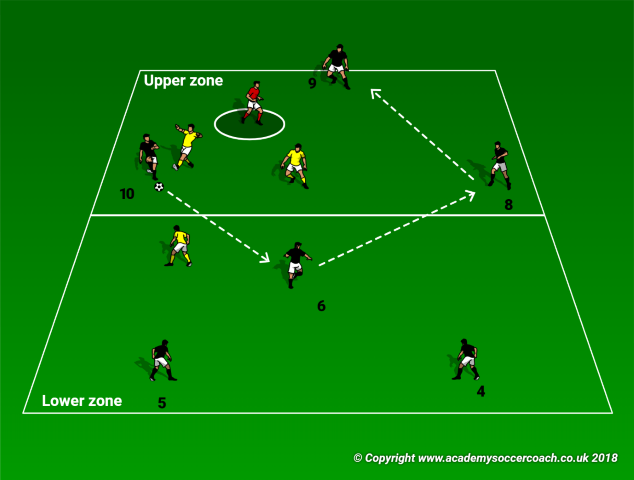
Conclusion
This book analyses the technical and tactical aspects required to play a possession dominant style of play taking Spanish soccer as a main source of reference. In order to dominate play, highly skilled players who are able to read the game at an exceptional level is required. Playing top level soccer, the players must not only be able to react quickly to continuously changing game situations, but must also be able to recognise the right stimuli to anticipate play. Therefore, always being one or two steps ahead of the opponent.
The training activities and sessions presented in this book are targeted to improve correct decision-making and speed of play. Players are thus all the time being stretched cognitively to make the right decisions. In soccer, decision-making, although performed by a single player, combines for a collective team effort. If a player has the ball, another player must make the right movements to get free of marking and receive the ball in space. The ball-carrier must also be able to select the right solution from a number of options, thus increasing the team’s chances of scoring.
This heavily involves team communication, which should therefore be present in all training situations. It is through such training situations that players develop strong relationship links between them. These links refer to the positions that are at close proximity with each other and in which players develop an awareness and an understanding of how they will behave as a group or sector in a particular moment of the game.
About the Author
Philip Joe Cauchi is a UEFA A and a UEFA A Youth Elite qualified soccer coach currently working in Malta. Philip’s area of expertise is in the development of tactical and game intelligence in youth soccer. His experience ranges from coaching eight year olds up to senior team levels. Cauchi is also a qualified soccer conditioning coach, a speed, agility and quickness licence holder and a physical education teacher. Cauchi has has also written many articles for the world renowned soccer website WORLD CLASS COACHING.
References
Allison, S. (2013). Coaching the Barcelona 4-3-3 – attacking. Kansas: World Class Coaching.
Bertolini, L. (2018). 35 possession rondos. Kansas: World Class Coaching.
Bordonau, J.L. & Villanueva, J. (2018). Tactical periodization – a proven successful training model. London: Soccer Tutor.
Casa Basile, P. (2015). Coaching positional play. London: Soccer Tutor.
Davies, J. C. (2013). Coaching the tiki taka style of play. London: Soccer Tutor.
Davies, J. C. (2016). The philosophy of football: In shadows of Marcelo Bielsa. London: Rocketbird.
Fletcher, L. (2018). Tips for coaches when delivering rondo practices. Retrieved October 21st, 2018 from The Coaching Manual. Website: https://www.thecoachingmanual.com/ Contect/6294374885359616
Gutiérrez Mayor, J. E. (2012). Possession: Play football the Spanish way. London: Soccer Tutor.
Grima, S. (2016). Foundations for a football culture (2nd ed.). Malta.
Grima, S. (2017). Effective football coaching sessions: Coaching using the 1-4-3-3 system. Malta.
Mallo, J. (2015). Complex football. Spain: TopProSoccer S.L.
Maurizi, A, (2018). La marcatura preventiva. Il nuovo calcio, 302, 30-33.
Minutillo, D. & Rafloski, R. (2015). A practical guide to tactical periodization. Kansas: World Class Coaching.
Pascual, J. (2013). Coaching Spanish soccer. Kansas: World Class Coaching.
Schreiner, P. & Elgert, N. (2013). Attacking Soccer – Mastering the modern game. Maidenhead: Meyer & Meyer Sport.
Tamboer, J. (2016). Football theory. Amsterdam: World Football Academy.
Van Kolfschooten, F. (2015). How simple can it be? Unique lessons in professional football: behind the scenes with Raymond Verheijen. Amsterdam: World Football Academy.
Verheijen, R. (2014). Football periodisation. Amsterdam: World Football Academy.


